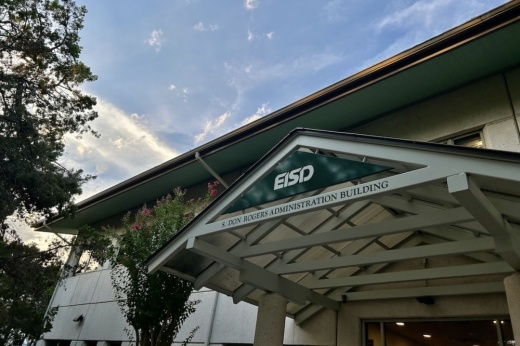Over 50 parents spoke out against a potential Barton Creek Elementary and Valley View Elementary campus blend—one measure presented by EISD officials—during the Nov. 19 board of trustees meeting.
How we got here
The potential blend was first proposed as a cost-saving measure to lessen EISD’s projected $6 million shortfall in 2025-26 during a Nov. 11 budget workshop.
Officials said the blend could save the district $2 million and accomplishes a few things, including allowing for the same class sizes and services offered and honoring the desire of the Valley View community to stay together.
However, because the blend would combine Barton Creek and Valley View students on the Barton Creek campus, bond-funded temporary portable classrooms would be required for capacity.
Breaking it down
The blended campus could see about 750 students based on a model created to project the number of 2025-26 kindergarten through fifth grade traditional and Spanish Immersion students and staff, said Chad Burnett, curriculum, instruction and assessment executive director.
The model includes temporarily stopping transfers of employees, out-of-district students, and in-district traditional and Spanish Immersion students at the kindergarten level.
Burnett said EISD’s classroom sectioning goal is 22 students to 1 teacher in kindergarten through fourth grade classrooms, while fifth grade “has some variability.” Based on the model, the blended campus could see classrooms—including Spanish Immersion classes—with an average of:
- 18.8 students in kindergarten
- 21.5 students in first grade
- 19.7 students in second grade
- 21.5 students in third grade
- 19.9 students in fourth grade
- 23.7 students in fifth grade
“That would increase our overall capacity to just over a thousand for students,” Burnett said. “That doesn’t mean we’re shooting to put over a thousand kids in the building at a time. What that tells us is now we have more capacity for classrooms. We have more capacity for space.”
What they’re saying
Many parents who spoke about the blend said it is a result of a districtwide budget struggle, but that the two campuses should not be targeted.
“Closing Valley View does not solve that problem," Valley View parent Lauren Amador said. "These are our neighbors and friends who have spent years taking care of your children, only to be treated as expendable by the district. ... It is so wrong and disheartening seeing this decision being driven by faulty assumptions with no real input from the staff or community.”
Other concerns shared included safety, traffic and parking, classroom sizes, lunch periods, and overall campus capacity. Barton Creek parent Sarah Saunders said her daughter already eats lunch at 10:15 a.m., and her kindergarten classroom is overcapacity at 23 students.
Many also said there are “less disruptive” and “more equitable” options available, such as rezoning the entire district or pausing transfers.
“I think the blend plan is based on a faulty assumption that [Barton Creek] and Valley View communities definitely want to stay together at all costs,” Barton Creek parent Amy Philip said. “You’ve heard over and over from parents all night saying, ‘We’re open to rezoning, please give us other options.’”
Looking ahead
Other cost-saving measures discussed during the Nov. 11 budget workshop included eliminating or modifying the Spanish Immersion program, adopting up to nine copper pennies through a voter-approval tax rate election and eliminating Personal Learning Communities periods.
These measures, combined with the Barton Creek and Valley View blend, could result in $8 million in savings and a possible $1.7 million budget surplus, per agenda documents.
Board President James Spradley said the board will likely need to start voting on what measures to move forward with in January in order to make timely decisions.
The 89th Texas Legislature is also slated to begin meeting in January. District officials are set to submit a list of legislative priorities in an attempt to garner additional state funding, which has been stagnant for years, to help offset increasing projected shortfalls.





